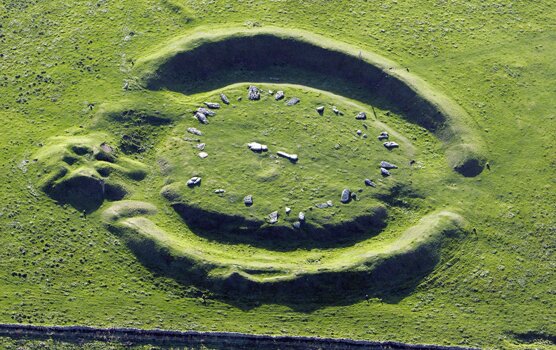Scheduled Monuments

Aerial view of Arbor Low Stone Circle and Gib Hill, Derbyshire: the region's most important prehistoric site, Arbor Low is a Neolithic henge monument atmospherically set amid high moorland.Within an earthen bank and ditch, a circle of some 50 white limestone slabs, all now fallen, surrounds a central stone 'cove' - a feature found only in major sacred sites. Nearby is enigmatic Gib Hill, a large burial mound © English Heritage Photo Library
What is scheduling?
What is the schedule? 'Scheduling' is shorthand for the process through which nationally important sites and monuments are given legal protection by being placed on a list, or 'schedule'. English Heritage takes the lead in identifying sites in England which should be placed on the schedule by the Secretary of State for Culture, Media and Sport. Anyone can apply for a site to be scheduled, using our online application form.
A schedule has been kept since 1882 of monuments whose preservation is given priority over other land uses. The current legislation, the Ancient Monuments and Archaeological Areas Act 1979, supports a formal system of Scheduled Monument Consent for any work to a designated monument.
Not all scheduled monuments are old. Archaeological sites from the prehistoric era, such as burial mounds, to 20th-century remains from the coal industry, World War II or the Cold War can be scheduled. Some monuments are difficult or impossible to see above ground, their form and layout only becoming clear from the air. Other sites have no visible remains above ground: it is their buried archaeological deposits which are of national importance. Standing buildings or ruins can also be given this type of protection. You can search for scheduled monuments in your area on the National Heritage List for England.
Once a site is scheduled, consent must be obtained from the Secretary of State for any works that affect it, with the exception of those noted under class consents.
- Contact for scheduling queries:
Applying for scheduled monument consent
Consent for works is granted by the Secretary of State and must be given in writing before works are started. English Heritage advises applicants and the Secretary of State on all consent applications. The applicant has a right to a public hearing before any decision is finally taken.
Guidance on the procedure for scheduled monument consent and an application form are available from the English Heritage website.
In most cases applications are successful. Early contact with the regional English Heritage office will help identify if there are any issues and help to agree a scheme that both preserves the site and meets your needs.
Scheduled Monument Clearance for Crown Bodies
Crown bodies must apply to English Heritage for scheduled monument clearance for works that affect a scheduled monument. Further information about crown immunity is available from the Government Historic Estate pages on the HELM website.
Crown bodies are also required (under the provisions of CLG Circular 02/06, paragraphs 92-93) to apply for clearance for works affecting any known archaeological remains, regardless of whether or not the site is scheduled.
Class Consents: works for which permission is granted automatically
Some types of work, generally related to agriculture or gardening, where these activities are already being carried out, are allowed to go ahead without consent. These are known as ‘class consents’. Building work is not included in class consent.
Urgent works required for healthy and safety are permitted by class consent 5. These works must be limited to the minimum measures immediately necessary. We recommend that you contact English Heritage or seek legal advice before undertaking any works that you believe fall within the class consents. The class consents can be found in the Ancient Monuments (Class Consents) Order 1994 (IS 1381).
Offences
It is against the law to- damage a scheduled monument by carrying out works without consent
- cause reckless or deliberate damage to a scheduled monument
- use a metal detector on a scheduled monument without a licence from English Heritage
- or remove an object found with a metal dector
Conviction for these offences can lead to fines.
Grants and Management
There is a range of grant incentive schemes for owners, including programmes run by Natural England for farmers or through Stewardship for land managers. English Heritage gives grants to help with major repairs. Our regional teams and Historic Environment Field Advisers can give owners advice on local schemes and general management issues.
What's New?
-
The National Heritage List for England is now live on the English Heritage website.
-
Welcome to the HER21 page. This page offers access to the full suite of HER21 project reports.
